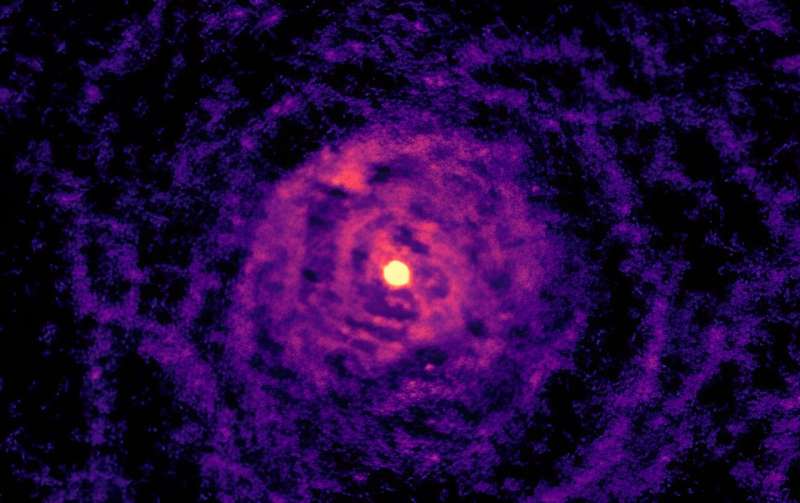This article has been reviewed according to Science X's editorial process and policies. Editors have highlighted the following attributes while ensuring the content's credibility:
fact-checked
peer-reviewed publication
trusted source
proofread
Cosmic chemistry unveils stellar dance: ALMA telescope discovers hidden orbit secrets

A team of international scientists, armed with the powerful ALMA telescope array in Chile, has unraveled the cosmic mysteries surrounding a dying star, revealing an intricate celestial dance shaped by unusual chemistry.
The study, published in Nature Astronomy, sheds light on the orbit of a cool red giant star, shedding its outer layers in a dramatic stellar wind during the twilight of its existence.
In a captivating exploration of the final stages of a star's life, researchers stumbled upon unexpected molecular emissions on one side of the star, a cosmic anomaly pointing to the involvement of a hotter companion star.
Lead author Dr. Taïssa Danilovich, an Australian Research Council (ARC) DECRA Fellow from the Monash University School of Physics and Astronomy said, "Once we noticed the peculiar silicon nitride emission on one side, we knew something extraordinary was unfolding."
This cosmic spectacle unfolds in the W Aquilae system, where the dying star is not a lone performer but shares its cosmic stage with a longer-lived sunlike star. Until now, the intricacies of their orbit remained veiled in cosmic mystery, with only speculation that it might span centuries.
However, recent revelations from the study provide a stunning answer—a highly elliptical orbit, taking approximately a millennium to complete one mesmerizing cycle.
The research team employed hydrodynamical simulations to decode the impact of the sunlike companion on the dying star's stellar wind.
Visualized as concentric rings when viewed from the side, these patterns were not just theoretical; they were vividly confirmed by ALMA data. Complemented by observations from the SPHERE instrument on the European Southern Observatory's Very Large Telescope and historic insights from the Hubble Space Telescope, the team unlocked the secrets of the stellar moves.
The implications extend beyond the cosmic stage of W Aquilae. The study pioneers a technique using ALMA to detect chemical signatures left by past stellar encounters, a tool that promises to unveil the hidden companions of other enigmatic dying stars shrouded in cosmic dust.
In a galaxy where nearly half of stars like our sun exist in pairs or triples, this research marks a crucial milestone in understanding how stellar companions shape the destinies of their celestial neighbors.
More information: T. Danilovich et al, Chemical tracers of a highly eccentric AGB–main-sequence star binary, Nature Astronomy (2024). DOI: 10.1038/s41550-023-02154-y
Journal information: Nature Astronomy
Provided by Monash University





















